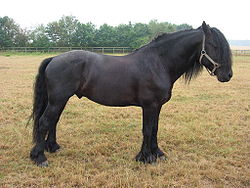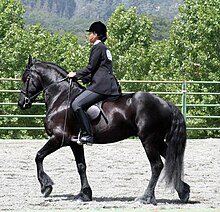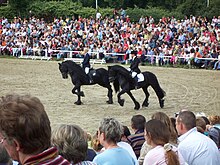Friezes
| Friezes | |
|---|---|

|
|
| Important data | |
| Origin: | West Friesland |
| Main breeding area: | Netherlands |
| Distribution: | widespread in Europe |
| Stick measure : | 155-175 cm |
| Colors : | only black |
| Main application area: | Driving and riding horse |
The Friesian or the Friesian horse is one of the oldest horse breeds in Europe, it is a Dutch horse breed that originally comes from the province of Friesland and is now bred in pure breeding without crossbreeding. The Friesch-Paarden Stamboek, the official stud book of the breed, has been kept since 1879. The seat of the stud book is Drachten .
Background information on horse evaluation and breeding can be found under: Exterior , interior and horse breeding .
Exterior
Frisians are sturdy horses with an arched, often set high and usually very strong neck, a well-angled and muscled hindquarters and a pronounced arching of the ribs. Today, Frisians are only selected for the black color of the black horse and are therefore usually pure-breeding for this color. The last brown mare named Patricia was entered in the stud book in 1928 . Browns no longer appear today; Foxes can very rarely appear, but they are not wanted. As Fuchsvererber known stallions are excluded from breeding. Also, the frieze must not have any white markings on the head or legs, but should be pure black from top to bottom. A star on the forehead is permitted, but undesirable.
Frisians often have lush long hair , which is why they are also known as long-haired horses in southern Germany and Austria . Frisians can also be recognized by the drop trimmings on their legs. This appearance has hardly changed since the 17th century . In recent years, Frisians of above-average size have been bred - which is due to the demand for a more sporty horse. Most mares reach heights of 155 to 165 cm, while the stallions grow taller. In order to be admitted to the licensing , the stallion must be at least 158 cm at the age of three or 160 cm at the age of four.
Until 1996, the Frisian was marked by a tongue tattoo instead of a brand , since 1996 microchips have been used to identify animals.
interior
Through the breeding of Iberian horses, the Frisian clearly gained dressage suitability . The high knee action, the lively basic gaits and especially his talent for high school make the Friesian a popular show and dressage horse. In addition, thanks to his strength, reliability, patience and gentleness, he can still be found frequently in front of the coach .
Breeding history
The Friesian horse is a Dutch breed of horse. As the name of the breed suggests, these horses originated in the province of Friesland .
The first mention of a horse that can be classified as a "Frieze" comes from Roman times. Tacitus and Julius Caesar mention the horse and it is described that the animals were exported to England by the Romans.
Today's modern Friesian horse was created in the 16th and 17th centuries by crossing Spanish horses into the then rather cold-blooded, regional horse type, while the Netherlands was occupied by Spain .
At the beginning of the 18th century, there was less and less riding in the stately homes, but more and more elegant, light carriages were used. For that you needed the right majestic horses.
When the Friesian horses became increasingly out of fashion in the 19th century, the breeding of the pure Frisian horses was neglected. In 1910 the number of stallions had shrunk to only four horses, three years later only the stallions Prins 109 , Alva 113 and Friso 117 were still alive. As a result, some breeders successfully campaigned to save the old breed. They realized that not only was an agricultural workhorse threatened with extinction, but also a piece of Dutch history, because the Friesian is the only Dutch horse breed. Today Frisians are mainly used as driving and riding horses.
Great efforts have been made by the breeders to ensure that the Friesian horse is spread today. However, after the crossbreeding of Spanish horses, non-racial blood was never again supplied. The population was secured and increased solely by inbreeding within the small population. Therefore, a so-called inbreeding factor is determined for every horse registered in the Dutch Friesian horse studbook ( Koninklijke Vereniging "Het Friesch Paarden-Stamboek" (KFPS) ) in Drachten in the province of Friesland . This indicates the percentage of inbreeding with which the genome of the animal is contaminated. In the 1970s a new, independent breeding line, the Arabo Friesian , was created by crossing Arabs . However, these no longer count among the Frisians.
The selection of stallions approved for breeding is one of the strictest in the world. Every year in autumn, all prospective stallions, mostly young stallions aged two and a half, face a jury. But also older animals, which may have already had success in riding and driving, are presented. A preselection is made and the best stallions are allowed to submit to another conformation assessment at the central licensing in January of the following year . There are two more selections until finally a few stallions are assigned to the stallion performance test . This takes place in autumn of the same year. The stallion candidates are therefore usually a good three and a half years old. There, again, only a few pass the difficult test, in which, in addition to the conformation and gait ability, for example, stable bearing and willingness to work are assessed.
But even if the stallion performance test has been successfully passed, an approved stallion has to face the jury every year and get his breeding license at the central licensing in Friesland. A final appraisal takes place only when the stallion's first foal crop is three years old after four to five years: A selection of the stallion's offspring is assessed as yearling, two-year-old and three-year-old and the stallion only remains in the breeding program if his contribution is assessed positively . If the stallion demonstrably does not make a positive contribution, he will be licensed and no longer listed as an approved stallion in the Dutch Friesian Stallion Studbook.
The Friesian horse studbook from 1879 is the oldest horse studbook in the Netherlands with 60,000 horses in over 50 countries today. Here the tests are carried out by the affiliated associations according to the same standards.
See also
literature
- Tomáš Míček (photographer), Hans-Jörg Schrenk: Friesland's black pearls. Friesian horses. About horse breeding and horse beauty . Kosmos, Stuttgart 1989, ISBN 978-3-440-06041-4 .
- Karin 't Hart: Friesian horses make friends. All about the most imposing black horses in the world . Sonia, Cologne 1997, ISBN 978-3-931790-03-5 .
- Petra van den Heuvel: Friesian horses. Horse riding. Drive. Hold . Cadmos, Lüneburg 2000, ISBN 978-3-86127-350-9 .
- Hermann Gerth, Rob Zethoven: Black athletes. From the beauty of Frisian stallions . Cadmos, Lüneburg 2003, ISBN 978-3-86127-397-4 .

